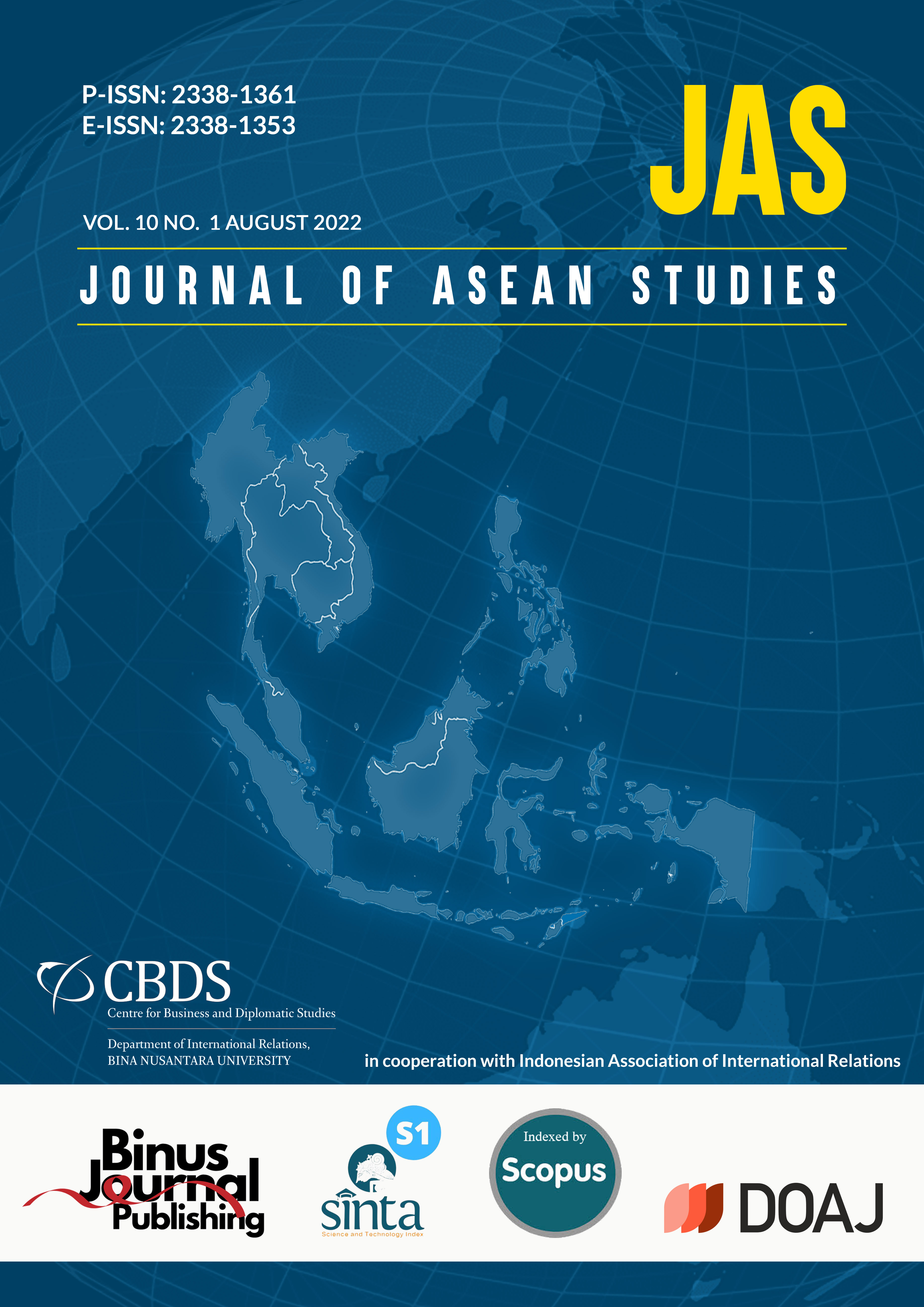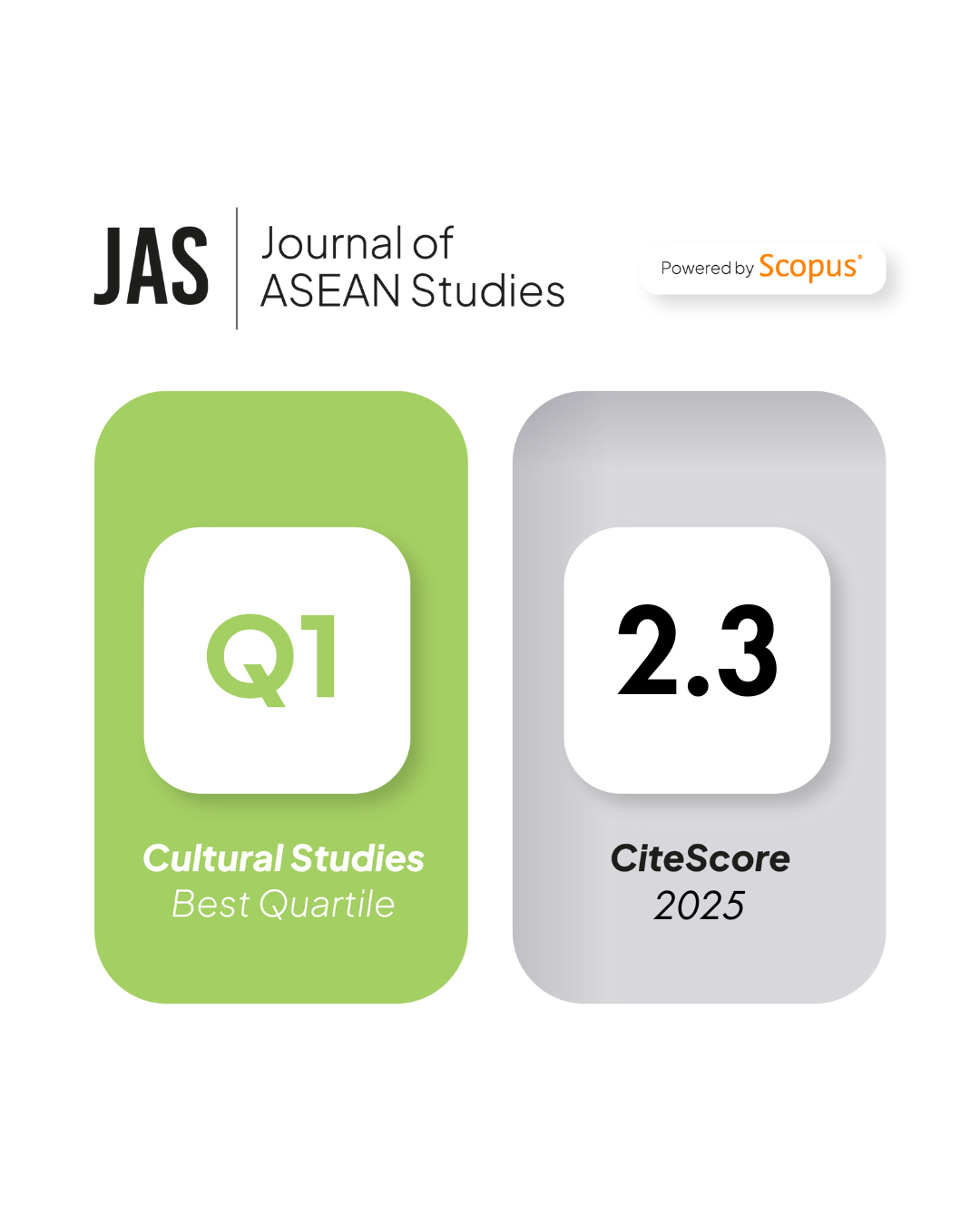The Effect of the Internet on Inflation: A Research on ASEAN-5 Countries
DOI:
https://doi.org/10.21512/jas.v10i1.7310Keywords:
internet, inflation, panel data analysis, ASEAN-5 CountriesAbstract
Information and communication technologies have become widespread with the onset of globalization, affecting almost every facet of human life. Increasing internet usage has made accessing information swift and easy. The internet has also had a significant economic impact and provided financial benefits to nations all around the world to increase productivity and efficiency and reduce costs. Customers had been able to access products at lower prices as a result of the reduction in market entry barriers and search costs, which led to an increase in competition in the markets. The research aimed to investigate the effect of the internet on inflation in ASEAN-5 countries (Indonesia, Malaysia, Philippines, Singapore, and Thailand). Consumer prices (annual %) were used as an indicator of inflation, and individuals using the internet (% of population) were used as an indicator of internet usage. Control variables such as unemployment rate, real interest rate, energy use and money growth were also included in the research. Panel data analysis was performed using the data of ASEAN-5 countries covering the period of 1994-2014. Pooled least squares method (Pooled OLS) was applied to obtain an estimation of the model. As a result, it is found that as internet usage increases, inflation rates decrease in ASEAN-5 countries.
References
Arellano, M. (1987). Computing robust standard errors for within-groups estimators. Oxford Bulletin of Economics and Statistics, 49(4), 431–434. https://doi.org/10.1111/j.1468-0084.1987.mp49004006.x
Breusch, T. S. & Pagan, A. R. (1979). A simple test for heteroscedasticity and random coefficient variation. Econometrica: Journal of the Econometric Society, 1287–1294. https://doi.org/10.2307/1911963
Calson-Öhman, F. (2018). The effect of increased e-commerce on inflation. [Master essay, Södertörns högskola – Institution for Social Sciences]. https://www.semanticscholar.org/paper/The-effect-of-increased-e-commerce-on-inflation-Calson-%C3%96hman/f92f752fdffa77d73c89f83bacf2a2d362ee6809
Cavallo, A. (2018). More Amazon effects: Online competition and pricing behaviors. Working Paper 25138. National Bureau of Economic Research. https://doi.org/10.3386/w25138
Charbonneau, K. B., Evans, A., Sarker, S., & Suchanek, L. (2017). Digitalization and inflation: A review of the literature. Staff Analytical Note, Bank of Canada. https://econpapers.repec.org/RePEc:bca:bocsan:17-20
Charnsripinyo, C. & Inluksana, S. (2015). National Broadband Policy, Ministry of Digital Economy and Society Thailand. http://www.mdes.go.th/view/10/Al lNews/e-Publication/24
Chavanne, X., Schinella, S., Marquet, D., Frangi, J. P., & Le Masson, S. (2015). Electricity consumption of telecommunication equipment to achieve a telemeeting. Applied Energy, 137, 273–281. https://doi.org/10.1016/j.apenergy.2014.10.027
Coffinet, J. & Perillaud, S. (2017). Effects of the internet on inflation: An overview of the literature and empirical analyses. Unpublished Manuscript.
Cook, R. D. & Weisberg, S. (1983). Diagnostics for heteroscedasticity in regression. Biometrika, 70(1), 1–10. https://doi.org/10.2307/2335938
Csonto, M. B., Huang, Y., & Mora, M. C. E. T. (2019). Is digitalization driving domestic inflation? Working Paper No. 19/271. International Monetary Fund.
Drukker, D. M. (2003). Testing for serial correlation in linear panel-data models. Stata Journal, 3(2), 168-177. https://doi.org/10.1177%2F1536867X0300300206
Ejemeyovwi, J. O., Osabuohien, E. S., Johnson, O. D., & Bowale, E. I. K. (2019). Internet usage, innovation and human development nexus in Africa: the case of ECOWAS. Journal of Economic Structures, 8(1), 15. https://doi.org/10.1186/s40008-019-0146-2
Eick, S. (2007). A history of Indonesian telecommunication reform 1999-2006. Proceedings of 40th Annual Hawaii International Conference on System Sciences No. 1530-1605/07. Institute of Electrical and Electronics Engineers Xplore Digital Library. https://doi.org/10.1109/HICSS.2007.16
Elgin, C. (2013). Internet usage and the shadow economy: Evidence from panel data. Economic Systems, 37(1), 111–121. https://doi.org/10.1016/j.ecosys.2012.08.005
Fabo, B. (2018). Implications of e-commerce for central banking: A review. Biatec, 26(4), 27–30. https://www.nbs.sk/_img/documents/_publik_nbs_fsr/biatec/rok2018/04-2018/07_biatec4_fabo.pdf
Friesenbichler, K. (2018). Inflation and broadband revisited: Evidence from an OECD Panel. A replication study of Yi and Choi (Journal of Policy Modeling, 2005). International Journal for Re-Views in Empirical Economics (IREE), 2(2018–1), 1–21. https://doi.org/10.18718/81781.5
Froot, K. A. (1989). Consistent covariance matrix estimation with cross-sectional dependence and heteroskedasticity in financial data. Journal of Financial and Quantitative Analysis, 333–355. https://doi.org/10.2307/2330815
Furuoka, F. & Munir, Q. (2009). “Phillips Curve†in selected ASEAN countries: New evidence from panel data analysis. Sunway Academic Journal, 6, 89–102.
Goolsbee, A. D. & Klenow, P. J. (2018). Internet rising, prices falling: Measuring inflation in a world of e-commerce. AEA Papers and Proceedings, 108, 488–492. https://doi.org/10.1257/pandp.20181038
Hettiarachchi, C. (2006). Role of information and communication technologies (ICTs) in human development in South Asia. Sri Lanka: Department of Management of Technology, University of Moratuwa.
Hsing, Y., Morgan, Y.-C., Phillips, A. S., & Phillips, C. (2020). Internet usage and economic growth: The case of Mexico. Quantitative Economics and Management Studies, 1(6), 383–389. https://doi.org/10.35877/454RI.qems224
Jing, A. H. Y. & Ab-Rahim, R. (2020). Information and Communication Technology (ICT) and economic growth in ASEAN-5 Countries. Journal of Public Administration and Governance, 10(2), 20-33.
Jo, Y. J., Matsumura, M., & Weinstein, D. E. (2019). The impact of e-commerce on relative prices and consumer welfare. NBER Working Paper 26506, National Bureau of Economic Research.
Koester, G., Lis, E., Nickel, C., Osbat, C., & Smets, F. (2021). Understanding low inflation in the euro area from 2013 to 2019: cyclical and structural drivers. ECB Strategy Review Occasional Paper Series No. 280.
Kose, N., Emirmahmutoglu, F., & Aksoy, S. (2012). The interest rate–inflation relationship under an inflation targeting regime: The case of Turkey. Journal of Asian Economics, 23(4), 476–485. https://doi.org/10.1016/j.asieco.2012.03.001
Koyuncu, J. Y. & Unver, M. (2018). The Impact of Internet on Inflation in OECD Countries. X. International Balkan and Near Eastern Social Science (IBANESS) Congress Series. Ohrid/Macedonia, pp. 261-265.
Kulakov, M. V. & Vinogradov, A. A. (2020). Study on the impact of e-commerce development on inflation in the euro area. π-Economy, 13(2), 129. https://doi.org/10.18721/JE.13210
Lindgren, C., Daunfeldt, S.-O., & Rudholm, N. (2021). Pricing in retail markets with low search costs: Evidence from a price comparison website. HFI Working Paper.
Litan, R. E. & Rivlin, A. M. (2001). Projecting the economic impact of the Internet. American Economic Review, 91(2), 313–317. http://dx.doi.org/10.1257/aer.91.2.313
Lv, L., Liu, Z., & Xu, Y. (2019). Technological progress, globalization and low-inflation: Evidence from the United States. PloS One, 14(4). https://doi.org/10.1371/journal.pone.0215366
Manyika, J. & Roxburgh, C. (2011). The great transformer: The impact of the Internet on economic growth and prosperity. McKinsey Global Institute, 1-9. https://www.mckinsey.com/industries/technology-media-and-telecommunications/our-insights/the-great-transformer
Matolcsy, G., Nagy, M., Palotai, D., & Virág, B. (2020). Inflation in the digital age: Inflation measurement and bias in the 21st Century. Financial and Economic Review, 19(1), 5–36. http://doi.org/10.33893/FER.19.1.536
Meijers, H. (2006). Diffusion of the Internet and low inflation in the information economy. Information Economics and Policy, 18(1), 1–23. http://dx.doi.org/10.1016/j.infoecopol.2005.02.005
Mentsiev, A. U., Khaliev, M. S. U., Guzueva, E. R., & Ashakhanova, M. Z. (2020). Digitalization as a New Stage in the Formation of Economic Relations. ISCFEC, 128, 3096–3100. https://dx.doi.org/10.2991/aebmr.k.200312.443
Nuccio, M. & Guerzoni, M. (2019). Big data: Hell or heaven? Digital platforms and market power in the data-driven economy. Competition & Change, 23(3), 312–328.
Piore, M. J. (1978). Unemployment and inflation: An alternative view. Challenge, 21(2), 24–32. https://doi.org/10.1080/05775132.1978.11470418
Priyono, A. F. (2016). Internet Dan Inflasi: Cross-Country Panel Analysis Atas 5 Negara Di Asia. Quantitative Economics Journal, 5(1). https://doi.org/10.24114/qej.v5i1.17481
Puzon, K. A. M. (2009). The inflation dynamics of the ASEAN-4: A case study of the Phillips curve relationship. The Journal of American Science, 5(1), 55–57.
Rogers, W. (1994). Regression standard errors in clustered samples. Stata Technical Bulletin, 3(13).
Romer, P. (1986). Increasing returns and Long-run growth. Journal of Political Economy, 94(5), 1002-1037.
Romer, P. (1990). Endogenous technical change. Journal of Political Economy, 98(5), S71–S102.
Ruslijanto, P. A. (2012). Digital Signature’s Legal Position in Electronic Commerce. International Proceedings of Economics Development and Research, 28. International Conference on Economics Marketing and Management. Singapore: IACSIT Press. http://www.ipedr.com/vol28 /36-ICEM M2012-G00001.pdf
Salahuddin, M., Alam, K., & Ozturk, I. (2016). The effects of Internet usage and economic growth on CO2 emissions in OECD countries: A panel investigation. Renewable and Sustainable Energy Reviews, 62(C), 1226–1235. https://doi.org/10.1016/j.rser.2016.04.018
Salahuddin, M. & Gow, J. (2016). The effects of Internet usage, financial development, and trade openness on economic growth in South Africa: A time series analysis. Telematics and Informatics, 33(4), 1141–1154. http://dx.doi.org/10.1016/j.tele.2015.11.006
Salleh, F., Yatin, S. F. M., Radzi, R. M., Kamis, M. S., Zakaria, S., Husaini, H., …, & Rambli, Y. R. (2020). Malaysian’s new digital initiative to boost e-commerce – Where we are. International Journal of Academic Research in Business and Social Sciences, 10(11), 1138-1154. http://dx.doi.org/10.6007/IJARBSS/v10-i11/8188
Salvatore, D. (2003). The new economy and growth in the G-7 countries. Journal of Policy Modeling, 25(5), 531-540.
Sassi, S. & Goaied, M. (2013). Financial development, ICT diffusion and economic growth: Lessons from MENA region. Telecommunications Policy, 37(4–5), 252–261. https://doi.org/10.1016/j.telpol.2012.12.004
Sathiaseelan, A., Trossen, D., Komnios, I., Ott, J., & Crowcroft, J. (2013). Information centric delay tolerant networking: An internet architecture for the challenged. Technical report, University of Cambridge, Computer Laboratory.
Shanthi, R. & Desti, K. (2015). Consumers’ perception on online shopping. Journal of Marketing and Consumer Research, 13, 14–21.
Simsim, M. T. (2011). Internet usage and user preferences in Saudi Arabia. Journal of King Saud University-Engineering Sciences, 23(2), 101–107. http://dx.doi.org/10.1016%2Fj.‌‌jksues.‌2011.03.006
Tatoğlu, F. Y. (2016). Panel Veri Ekonometrisi Stata Uygulamalı. Beta Yayınevi, Genişletilmiş 3. baskı, İstanbul.
Thoma, M. A. (1994). The effects of money growth on inflation and interest rates across spectral frequency bands. Journal of Money, Credit and Banking, 26(2), 218–231. https://doi.org/10.2307/2077906
Villegas, B. M. (2014). The ICT sector in the Philippine economy. Nomura Foundation. https://www.nomurafoundation.or.jp/en/wordpress/wpcontent/uploads/2014/09/20010525_Bernardo_Villegas.pdf
Vu, K. M. (2013). Information and Communication Technology (ICT) and Singapore’s economic growth. Information Economics and Policy, 25(4), 284–300. https://‌doi.org/‌10.1016/‌j.infoecopol.2013.08.002
Wadhwani, S. (2000). The impact of the Internet on UK inflation. Bank of England Quarterly Bulletin.
Wasti, S. K. A. & Zaidi, S. W. (2020). An empirical investigation between CO2 emission, energy consumption, trade liberalization and economic growth: A case of Kuwait. Journal of Building Engineering, 28. https://doi.org/10.1016/j.jobe.2019.101104
Wooldridge, J. M. (2002). Econometric Analysis of Cross Section and Panel Data. Cambridge: The MIT Press.
Yi, M. H. & Choi, C. (2005). The effect of the internet on inflation: Panel data evidence. Journal of Policy Modeling, 27(7), 885–889. https://doi.org/10.1016/j.jpolmod.2005.06.008
Downloads
Published
How to Cite
Issue
Section
License
Copyright (c) 2022 Mustafa Necati Çoban

This work is licensed under a Creative Commons Attribution-NonCommercial 4.0 International License.






















